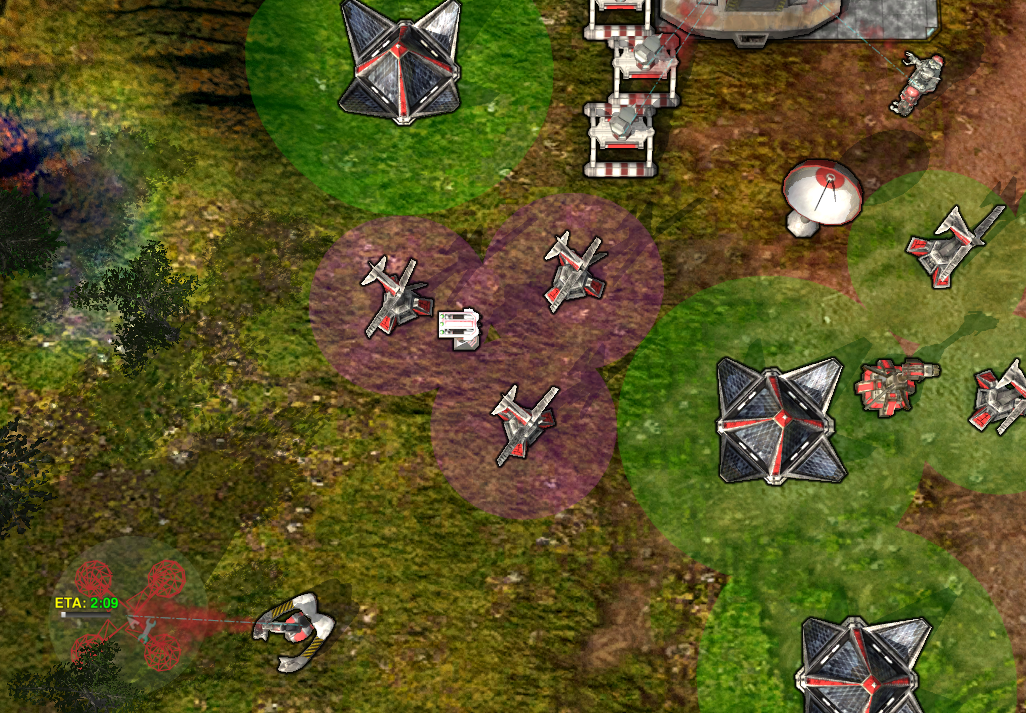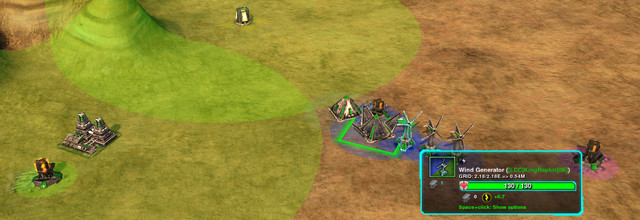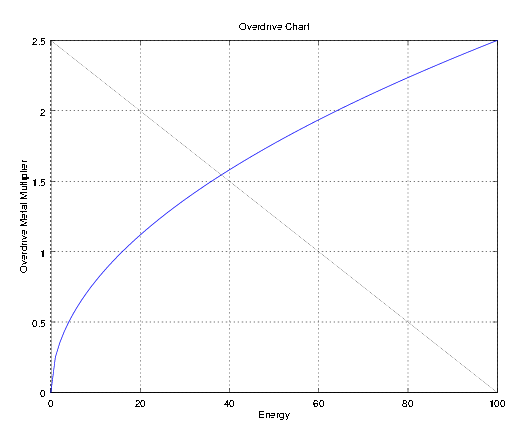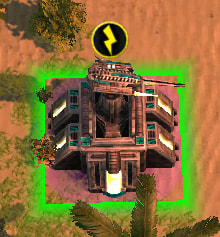Difference between revisions of "Overdrive"
m |
GoogleFrog (talk | contribs) |
||
| (4 intermediate revisions by 2 users not shown) | |||
| Line 1: | Line 1: | ||
| − | '''Overdrive''' is an ability of [[Metal Extractor]]s that allows them to drain [[Energy]] to increase their [[Metal]] income. | + | '''Overdrive''' is an ability of [[Metal Extractor]]s that allows them to drain [[Energy]] to increase their [[Metal]] income. The '''Energy Grid''' provides Metal Extractors with energy, and is also required by superweapons, powerful defensive structures, and the Strider Hub. |
== Summary == | == Summary == | ||
| − | To view your energy grid, | + | Every structure that uses the energy grid projects a circle of grid influence. Structures link together into the same grid when their circles touch, and the total energy of the grid is the sum of the energy production of its energy structures. Total grid energy limits the energy availible for overdrive, and is used as a threshold for activating some advanced structures, such as [[Lucifer]], [[Desolator]] and [[Cerberus]]. |
| − | * Circles around Metal Extractors and | + | |
| + | To view your energy grid, select any energy structure or energy structure build option. The grid can also be seen by toggling the economy view via the hotkey {{key press|F4}} (by default) or by clicking the <samp>[[File:metalmap.png|text-top|green sphere]] Toggle Economy Display</samp> icon in the top left corner. | ||
| + | * Circles around Metal Extractors, energy structures, and advanced structure show their grid influence. | ||
* Structures are in the same grid if their circles overlap. | * Structures are in the same grid if their circles overlap. | ||
| − | * The | + | * Grid colour indicates overdrive efficiency. The more energy a Metal Extractor uses, the less efficient Overdrive will be. |
* Grids between allies can be connected. | * Grids between allies can be connected. | ||
| − | |||
| − | |||
| − | === Grid | + | === Grid Efficiency === |
| − | * If a grid is pink or purple, | + | A grid's colour is a guide to what the grid needs. |
| − | * If a grid is light blue or green, keep adding energy. | + | * If a grid is pink or purple, it has no Metal Extractors or there is no excess energy. Build more energy structures and make sure to connect some to Metal Extractors. |
| + | * If a grid is light blue or green, keep adding energy structures. | ||
* If a grid is yellow or red, the grid is inefficient. Spread out the energy by expanding the grid to connect more Metal Extractors. | * If a grid is yellow or red, the grid is inefficient. Spread out the energy by expanding the grid to connect more Metal Extractors. | ||
== Explanation of Overdrive == | == Explanation of Overdrive == | ||
| − | The energy | + | Overdrive works by spending excess energy to multiply metal income. The energy is spent on each Metal Rxtractor individually, with diminishing returns. The total energy spent among the Metal Extractors in a grid is limited by the total energy of the grid. The grid only sets a cap on how much energy can be spent within it. The energy available for overdrive from second to second is dependent on a team's energy storage, income and expenditure, according to the following formula: |
| − | |||
| − | |||
| − | The energy available to | ||
<!--<code>Energy for Overdrive = (income - expenditure) * (storage / capacity)</code>--> | <!--<code>Energy for Overdrive = (income - expenditure) * (storage / capacity)</code>--> | ||
<var>Energy for Overdrive</var> = (<var>income</var> − <var>expenditure</var>) × {{frac|<var>storage</var>|<var>capacity</var>}} | <var>Energy for Overdrive</var> = (<var>income</var> − <var>expenditure</var>) × {{frac|<var>storage</var>|<var>capacity</var>}} | ||
| − | A team with full energy storage spends all of its excess energy on Overdrive | + | A team with full energy storage spends all of its excess energy on Overdrive. All the available energy is spent, provided there are sufficient grid connections. |
| − | |||
| − | |||
=== Metal Generation === | === Metal Generation === | ||
| − | + | The overdrive metal generated by a Metal Extractor depends on the amount of energy it spends, according to the following formula: | |
<!--<code>Overdrive Metal = (Base Income) * (sqrt(energy)/4)</code>--> | <!--<code>Overdrive Metal = (Base Income) * (sqrt(energy)/4)</code>--> | ||
<var>Overdrive Metal</var> = <var>Base Income</var> × {{frac|{{sqrt|<var>energy</var>}}|4}} | <var>Overdrive Metal</var> = <var>Base Income</var> × {{frac|{{sqrt|<var>energy</var>}}|4}} | ||
| − | For example, a | + | For example, a Metal Extractor with 2.2 base income and 4 Overdrive Energy generates <span style="white-space:nowrap">2.2 × {{frac|{{sqrt|4}}|4}} = 1.1</span> Overdrive Metal. |
== Efficiency Tips == | == Efficiency Tips == | ||
| − | + | The color of an overdrive grid is related to the ratio of the energy it spends to the metal it produces. Pink means that there is currently no metal being produced. If a structure is disabled for any reason ([[Weapon classes#EMP|<abbr title="Electromagnetic pulse">EMP</abbr>]], for instance), it loses its grid connecting functionality, and its field turns gray to indicate this. | |
[[Image:Pylongrid.sized.jpg]] | [[Image:Pylongrid.sized.jpg]] | ||
| + | |||
| + | Grids with the same color do not need to be linked, as they are operating at the same efficiency. | ||
| + | [[File:GridColour.png]] | ||
=== Diminishing Returns === | === Diminishing Returns === | ||
| Line 46: | Line 45: | ||
The Overdrive equation has diminishing returns. It takes 16 Energy initially to double the income of a mex, and a further 48 energy (64 in total) to increase the output to triple its income. As a result, your metal to energy conversion ratio improves as more mexes are built and added to the grid. | The Overdrive equation has diminishing returns. It takes 16 Energy initially to double the income of a mex, and a further 48 energy (64 in total) to increase the output to triple its income. As a result, your metal to energy conversion ratio improves as more mexes are built and added to the grid. | ||
| − | For example, compare four +2 mexes in a grid to | + | For example, compare four +2 mexes in a grid to four +2 mexes, but with only one mex is a grid. Each of the grids is allocated 16 energy. |
| + | {| class="wikitable" | ||
| + | |- | ||
| + | ! !! Connected Grid !! Disconnected Grid | ||
| + | |- | ||
| + | | Base Income Per Mex || +2 || +2 | ||
| + | |- | ||
| + | | Total Base Income|| +8 || +8 | ||
| + | |- | ||
| + | | Energy Per Mex|| 4 || 16 for one, 0 for the other three | ||
| + | |- | ||
| + | | Overdrive Multiplier || 50% || 100% for one, 0% for the other three | ||
| + | |- | ||
| + | | Overdrive Income Per Mex || +1 || +2 for one, 0 for the other three | ||
| + | |- | ||
| + | | Total Overdrive Income || +4 || +2 | ||
| + | |- | ||
| + | | Total Income || +12 || +10 | ||
| + | |} | ||
| − | In practice, only about half of your extractors need to be linked to an Overdrive grid for most games. The cost and risk of linking extra extractors can be too great for the minimal gain of linking an already efficient grid. It can be advantageous to construct a few small energy structures next to many of your mexes to take advantage of the highly efficient low levels of overdrive. | + | Spreading your Overdrive, and thus your grid, between many Metal Extractors improves the efficiency of your Overdrive. In practice, only about half of your extractors need to be linked to an Overdrive grid for most games. The cost and risk of linking extra extractors can be too great for the minimal gain of linking an already efficient grid. It can be advantageous to construct a few small energy structures next to many of your mexes to take advantage of the highly efficient low levels of overdrive. |
=== High-Income Mexes === | === High-Income Mexes === | ||
| − | Overdrive works by | + | Overdrive works by multiplying base income, so Metal spots with unusually high income are particularly important to overdrive. Such Metal spots can be found in the center of many maps, which makes the task of overdriving them safely quite difficult. |
| − | The Overdrive equation has been solved to optimally distribute energy to | + | The Overdrive equation has been solved to optimally distribute energy between mexes to yield the greatest income, so you never need to worry about connecting mexes with different incomes to your grids. Try to capture Metal spots with high income and overdrive them as much as possible. These extractors will max their grid sooner than others, so keep track of their energy usage. |
=== Tooltips === | === Tooltips === | ||
| Line 71: | Line 88: | ||
|+ Payback Time for Overdrive (minutes) | |+ Payback Time for Overdrive (minutes) | ||
|- | |- | ||
| − | !colspan="2" scope="col"|Color!!scope="col"|<abbr title="Energy per Metal">E/M</abbr>!!scope="col" style="width:3em"|Solar!!scope="col" style="width:3em"|Tidal!!scope="col" style="width:3em"|Fusion!!scope="col" style="width:3em"|Geo!!scope="col" style="width:3em"|Singu!!scope="col" style="width:3em"|Adv. Geo | + | !colspan="2" scope="col"|<div style="display:none">[[File:Overdrive_vGradient_1.png|10x10px]]</div>Color!!scope="col"|<abbr title="Energy per Metal">E/M</abbr>!!scope="col" style="width:3em"|Solar!!scope="col" style="width:3em"|Tidal!!scope="col" style="width:3em"|Fusion!!scope="col" style="width:3em"|Geo!!scope="col" style="width:3em"|Singu!!scope="col" style="width:3em"|Adv. Geo |
|- | |- | ||
|rowspan="15" style="padding:0"|<img src="{{filepath:Overdrive_vGradient_1.png}}" style="width:100%;height:31em;border:none;padding:0;margin:0" alt="Color gradient (0 to 14 E/M)."> | |rowspan="15" style="padding:0"|<img src="{{filepath:Overdrive_vGradient_1.png}}" style="width:100%;height:31em;border:none;padding:0;margin:0" alt="Color gradient (0 to 14 E/M)."> | ||
| Line 138: | Line 155: | ||
|+ Payback Time for Overdrive (Red Zone) | |+ Payback Time for Overdrive (Red Zone) | ||
|- | |- | ||
| − | !colspan="2" scope="col"|Color!!scope="col"|<abbr title="Energy per Metal">E/M</abbr>!!scope="col" style="width:3em"|Solar!!scope="col" style="width:3em"|Tidal!!scope="col" style="width:3em"|Fusion!!scope="col" style="width:3em"|Geo!!scope="col" style="width:3em"|Singu!!scope="col" style="width:3em"|Adv. Geo | + | !colspan="2" scope="col"|<div style="display:none">[[File:Overdrive_vGradient_2.png|10x10px]]</div>Color!!scope="col"|<abbr title="Energy per Metal">E/M</abbr>!!scope="col" style="width:3em"|Solar!!scope="col" style="width:3em"|Tidal!!scope="col" style="width:3em"|Fusion!!scope="col" style="width:3em"|Geo!!scope="col" style="width:3em"|Singu!!scope="col" style="width:3em"|Adv. Geo |
|- | |- | ||
|rowspan="15" style="padding:0"|<img src="{{filepath:Overdrive_vGradient_2.png}}" style="width:100%;height:31em;border:none;padding:0;margin:0" alt="Color gradient (15 to 29 E/M)."> | |rowspan="15" style="padding:0"|<img src="{{filepath:Overdrive_vGradient_2.png}}" style="width:100%;height:31em;border:none;padding:0;margin:0" alt="Color gradient (15 to 29 E/M)."> | ||
| Line 200: | Line 217: | ||
!scope="row"|29 | !scope="row"|29 | ||
|16:55||14:06||13:49||9:40||8:36||7:15 | |16:55||14:06||13:49||9:40||8:36||7:15 | ||
| − | |} | + | |}{{clear}} |
| − | {{clear}} | ||
Wind generators are not part of this table because their output varies as the wind strength changes. They can, however, be very efficient, especially since they take very little time to build and can start providing resources sooner than more expensive options. | Wind generators are not part of this table because their output varies as the wind strength changes. They can, however, be very efficient, especially since they take very little time to build and can start providing resources sooner than more expensive options. | ||
| Line 207: | Line 223: | ||
[[File:nopower.jpg|frame|A disconnected Lucifer will not fire.]] | [[File:nopower.jpg|frame|A disconnected Lucifer will not fire.]] | ||
| − | Some defense structures, like [[Cerberus]], [[Desolator]] and [[Lucifer]], require connection to a grid. The grid must have a minimum | + | Some defense structures, like [[Cerberus]], [[Desolator]] and [[Lucifer]], require connection to a grid. The grid must have a minimum total energy for these structures to activate. The energy is not spent by these structures, it is just a minimum threshold, so any number of the same structure can be activated by a grid. If a structure is not connected to a sufficiently powerful grid, an energy icon will display over it and the structure will not function. |
| − | |||
| − | If a | ||
{{Navbox manual}} | {{Navbox manual}} | ||
| + | [[Category:Resources]] | ||
Latest revision as of 16:48, 26 December 2023
Overdrive is an ability of Metal Extractors that allows them to drain Energy to increase their Metal income. The Energy Grid provides Metal Extractors with energy, and is also required by superweapons, powerful defensive structures, and the Strider Hub.
Contents
Summary[edit]
Every structure that uses the energy grid projects a circle of grid influence. Structures link together into the same grid when their circles touch, and the total energy of the grid is the sum of the energy production of its energy structures. Total grid energy limits the energy availible for overdrive, and is used as a threshold for activating some advanced structures, such as Lucifer, Desolator and Cerberus.
To view your energy grid, select any energy structure or energy structure build option. The grid can also be seen by toggling the economy view via the hotkey F4 (by default) or by clicking the ![]() Toggle Economy Display icon in the top left corner.
Toggle Economy Display icon in the top left corner.
- Circles around Metal Extractors, energy structures, and advanced structure show their grid influence.
- Structures are in the same grid if their circles overlap.
- Grid colour indicates overdrive efficiency. The more energy a Metal Extractor uses, the less efficient Overdrive will be.
- Grids between allies can be connected.
Grid Efficiency[edit]
A grid's colour is a guide to what the grid needs.
- If a grid is pink or purple, it has no Metal Extractors or there is no excess energy. Build more energy structures and make sure to connect some to Metal Extractors.
- If a grid is light blue or green, keep adding energy structures.
- If a grid is yellow or red, the grid is inefficient. Spread out the energy by expanding the grid to connect more Metal Extractors.
Explanation of Overdrive[edit]
Overdrive works by spending excess energy to multiply metal income. The energy is spent on each Metal Rxtractor individually, with diminishing returns. The total energy spent among the Metal Extractors in a grid is limited by the total energy of the grid. The grid only sets a cap on how much energy can be spent within it. The energy available for overdrive from second to second is dependent on a team's energy storage, income and expenditure, according to the following formula:
Energy for Overdrive = (income − expenditure) × storagecapacity
A team with full energy storage spends all of its excess energy on Overdrive. All the available energy is spent, provided there are sufficient grid connections.
Metal Generation[edit]
The overdrive metal generated by a Metal Extractor depends on the amount of energy it spends, according to the following formula:
Overdrive Metal = Base Income × √energy4
For example, a Metal Extractor with 2.2 base income and 4 Overdrive Energy generates 2.2 × √44 = 1.1 Overdrive Metal.
Efficiency Tips[edit]
The color of an overdrive grid is related to the ratio of the energy it spends to the metal it produces. Pink means that there is currently no metal being produced. If a structure is disabled for any reason (EMP, for instance), it loses its grid connecting functionality, and its field turns gray to indicate this.
Grids with the same color do not need to be linked, as they are operating at the same efficiency.

Diminishing Returns[edit]
The Overdrive equation has diminishing returns. It takes 16 Energy initially to double the income of a mex, and a further 48 energy (64 in total) to increase the output to triple its income. As a result, your metal to energy conversion ratio improves as more mexes are built and added to the grid.
For example, compare four +2 mexes in a grid to four +2 mexes, but with only one mex is a grid. Each of the grids is allocated 16 energy.
| Connected Grid | Disconnected Grid | |
|---|---|---|
| Base Income Per Mex | +2 | +2 |
| Total Base Income | +8 | +8 |
| Energy Per Mex | 4 | 16 for one, 0 for the other three |
| Overdrive Multiplier | 50% | 100% for one, 0% for the other three |
| Overdrive Income Per Mex | +1 | +2 for one, 0 for the other three |
| Total Overdrive Income | +4 | +2 |
| Total Income | +12 | +10 |
Spreading your Overdrive, and thus your grid, between many Metal Extractors improves the efficiency of your Overdrive. In practice, only about half of your extractors need to be linked to an Overdrive grid for most games. The cost and risk of linking extra extractors can be too great for the minimal gain of linking an already efficient grid. It can be advantageous to construct a few small energy structures next to many of your mexes to take advantage of the highly efficient low levels of overdrive.
High-Income Mexes[edit]
Overdrive works by multiplying base income, so Metal spots with unusually high income are particularly important to overdrive. Such Metal spots can be found in the center of many maps, which makes the task of overdriving them safely quite difficult.
The Overdrive equation has been solved to optimally distribute energy between mexes to yield the greatest income, so you never need to worry about connecting mexes with different incomes to your grids. Try to capture Metal spots with high income and overdrive them as much as possible. These extractors will max their grid sooner than others, so keep track of their energy usage.
Tooltips[edit]
The tooltips of Metal Extractors have information to display how efficient your Overdrive is. For example:
- Metal Extractor—Income: X + Y% Overdrive
Energy: -Z - This shows the state of a single extractor. X is the base Metal income of the extractor. Y% is the extra Metal income from overdrive. Z is the Energy used by this extractor to produce the extra Y% of income.
- Y and Z are always related by
- Y = 100 × √Z4
- Energy source—Grid: Y/Z E => X M
- This shows the behavior of the energy grid that the structure is part of. X shows the total extra Metal produced due to Overdrive in this grid. Y shows the total energy expended to produce this metal. Z shows the Energy production of all the energy structures of the grid. Z is the upper bound of Y.
General Investment Payback Time[edit]
The color coding on an energy grid is determined by the amount of energy required to make 1 Metal. From this, you can roughly approximate how long it will take for an energy structure to repay its Metal cost in overdrive based on grid color. These numbers are theoretical and not exact in a game environment, but a good guideline.
| Color | E/M | Solar | Tidal | Fusion | Geo | Singu | Adv. Geo | |
|---|---|---|---|---|---|---|---|---|

|
Pink | 0 | 0:00 | 0:00 | 0:00 | 0:00 | 0:00 | 0:00 |
| Purple | 1 | 0:35 | 0:29 | 0:29 | 0:20 | 0:18 | 0:15 | |
| Purple | 2 | 1:10 | 0:58 | 0:57 | 0:40 | 0:36 | 0:30 | |
| Purple | 3 | 1:45 | 1:28 | 1:26 | 1:00 | 0:53 | 0:45 | |
| Blue | 4 | 2:20 | 1:57 | 1:54 | 1:20 | 1:11 | 1:00 | |
| Turquoise | 5 | 2:55 | 2:26 | 2:23 | 1:40 | 1:29 | 1:15 | |
| Green | 6 | 3:30 | 2:55 | 2:51 | 2:00 | 1:47 | 1:30 | |
| Bright Green | 7 | 4:05 | 3:24 | 3:20 | 2:20 | 2:04 | 1:45 | |
| Green-Yellow | 8 | 4:40 | 3:53 | 3:49 | 2:40 | 2:22 | 2:00 | |
| Yellow | 9 | 5:15 | 4:23 | 4:17 | 3:00 | 2:40 | 2:15 | |
| Gold | 10 | 5:50 | 4:52 | 4:46 | 3:20 | 2:58 | 2:30 | |
| Tangerine | 11 | 6:25 | 5:21 | 5:14 | 3:40 | 3:16 | 2:45 | |
| Orange | 12 | 7:00 | 5:50 | 5:43 | 4:00 | 3:33 | 3:00 | |
| Orange Peel | 13 | 7:35 | 6:19 | 6:11 | 4:20 | 3:51 | 3:15 | |
| Dark Orange | 14 | 8:10 | 6:48 | 6:40 | 4:40 | 4:09 | 3:30 | |
| Color | E/M | Solar | Tidal | Fusion | Geo | Singu | Adv. Geo | |
|---|---|---|---|---|---|---|---|---|

|
15 | 8:45 | 7:18 | 7:09 | 5:00 | 4:27 | 3:45 | |
| 16 | 9:20 | 7:47 | 7:37 | 5:20 | 4:44 | 4:00 | ||
| 17 | 9:55 | 8:16 | 8:06 | 5:40 | 5:02 | 4:15 | ||
| 18 | 10:30 | 8:45 | 8:34 | 6:00 | 5:20 | 4:30 | ||
| 19 | 11:05 | 9:14 | 9:03 | 6:20 | 5:38 | 4:45 | ||
| 20 | 11:40 | 9:43 | 9:31 | 6:40 | 5:56 | 5:00 | ||
| 21 | 12:15 | 10:13 | 10:00 | 7:00 | 6:13 | 5:15 | ||
| 22 | 12:50 | 10:42 | 10:29 | 7:20 | 6:31 | 5:30 | ||
| 23 | 13:25 | 11:11 | 10:57 | 7:40 | 6:49 | 5:45 | ||
| 24 | 14:00 | 11:40 | 11:26 | 8:00 | 7:07 | 6:00 | ||
| 25 | 14:35 | 12:09 | 11:54 | 8:20 | 7:24 | 6:15 | ||
| 26 | 15:10 | 12:38 | 12:23 | 8:40 | 7:42 | 6:30 | ||
| 27 | 15:45 | 13:08 | 12:51 | 9:00 | 8:00 | 6:45 | ||
| 28 | 16:20 | 13:37 | 13:20 | 9:20 | 8:18 | 7:00 | ||
| 29 | 16:55 | 14:06 | 13:49 | 9:40 | 8:36 | 7:15 | ||
Wind generators are not part of this table because their output varies as the wind strength changes. They can, however, be very efficient, especially since they take very little time to build and can start providing resources sooner than more expensive options.
High-Energy Weapons[edit]
Some defense structures, like Cerberus, Desolator and Lucifer, require connection to a grid. The grid must have a minimum total energy for these structures to activate. The energy is not spent by these structures, it is just a minimum threshold, so any number of the same structure can be activated by a grid. If a structure is not connected to a sufficiently powerful grid, an energy icon will display over it and the structure will not function.


